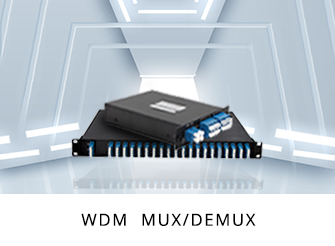DWDM (dense wavelength division multiplexing) is a combination of optical wavelengths that can be transmitted by one optical fiber. It is a laser technology used to increase the bandwidth of the existing optical fiber backbone. It enables the optical fiber network to transmit signals of multiple wavelengths at the same time. In DWDM system, MUX / demux are two indispensable components.
What is DWDM MUX / demux?
DWDM (dense wavelength division multiplexing) is an optical multiplexing technology, which is used to increase the bandwidth of the existing optical backbone network.
Data from various sources are placed on the optical fiber, where each signal propagates at the same speed with its own optical wavelength. In DWDM system, MUX / demux are two indispensable modules, MUX (multiplexer) is a module at the transmitting end, which aggregates multiple data signals to be transmitted through a single optical fiber, and demux (multiplexer) is a module at the receiving end, It separates the signals gathered together and passes each channel to a fiber receiver.
The DWDM MUX / demux module is used to multiplex multiple DWDM channels into one or two optical fibers.
How does DWDM MUX / demux work?
The DWDM Network structure starts with a transponder or transceiver that receives data input from various traffic types and protocols, which performs the basic function of mapping input data to individual DWDM wavelengths, each individual wavelength will be fed to a multiplexer, which filters and combines multiple wavelengths into a single output port for transmission through the main DWDM fiber.
Then, at the receiving end, each channel can be isolated by using demux to separate wavelengths, and then each channel can be routed to the appropriate client output through an additional wavelength matching transponder or transceiver
What factors to consider when selecting DWDM multiplexer / demultiplexer?
Line port
The line port is one of the important ports for multiplexing and demultiplexing each DWDM channel. There are two kinds of line ports: dual fiber and single fiber. The choice depends on the purpose of DWDM wavelength. For single fiber DWDM MUX / demux, it only needs one single fiber to transmit signals.
However, the transmission line may be unidirectional or bidirectional.
Single fiber unidirectional means that the optical module is only connected by one optical fiber, and the signal can only be sent from the sending end to the receiving end, and cannot be reversed. The advantage of this transmission is that the system is relatively easy to design and more convenient for independent wavelength monitoring. The following figure can be used as a reference for single fiber unidirectional transmission:
Single fiber bidirectional is used to simultaneously transmit and receive optical signals in two directions in one optical fiber, just like the positive and negative lanes separated by the isolation belt on the road. Vehicles on both sides of the road run on their own lanes without interference. The advantages are also obvious. The single fiber bidirectional technology can only use one fiber to complete the work that two fibers can do, doubling the existing fiber transmission capacity and greatly saving fiber resources. The following figure can be used as a reference for single fiber bidirectional transmission:
Dual fiber DWDM MUX / demux uses two optical fibers, one of which only transmits optical signals in one direction and the other transmits optical signals in the other direction. The advantage is that dual fiber DWDM MUX / demux requires two optical fibers for transmission, and each signal is carried by different wavelengths, which will not affect each other and has higher reliability.
Channel port
Like line ports, channel ports are another important port. DWDM MUX / demux usually has multiple channel ports with different wavelengths, and each channel port is suitable for a specific wavelength. DWDM MUX / demux usually has 4-96 channel ports, with a wavelength range of 1470nm ~ 1625nm, and a channel spacing of 0.8nm (100GHz) or 0.4nm (50GHz). DWDM MUX / demux with more channels provides more capacity, But the price will also be higher.
Monitoring port
In addition to the necessary line ports and channel ports, DWDM MUX / demux can also add other ports such as monitoring ports for better network monitoring and management. The monitoring port provides a flexible monitoring mode, which can test the power, wavelength and optical signal-to-noise ratio (OSNR) of the optical signal without interrupting the service. In addition, if there is any deviation, it can give a timely warning. Therefore, it can also improve the stability of the system transmission. The monitoring port can be a simplex or duplex fiber port, depending on the DWDM MUX / demux type you are using. The simplex optical port can only monitor DWDM, while the duplex optical port can monitor the entire network.





